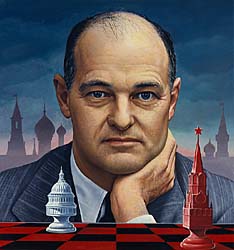

As charg‚ d'affaires in Moscow in the mid-1940s, George F. Kennan understood the Russian Marxist way of thinking better than any other American. Nevertheless, Kennan was little appreciated outside of diplomatic circles in Washington, and within those circles his early warnings about Soviet behavior largely went unheeded. Then in 1946 he had the occasion to send an extraordinarily long telegram (8,000 words) back to Washington, underscoring the centuries-old "Russian sense of insecurity" and opportunism that welded the Kremlin "fanatically to the belief that with the U.S. there can be no permanent modus vivendi." Subsequent diplomatic failures with Moscow to reach peace accords for Germany and Austria gave credence to Kennan's views. He warned that freedom in Europe would be dangerously compromised unless the United States forged strong Western alliances. In the spring of 1947, Secretary of State George Marshall selected Kennan to head the department's newly established Policy Planning Staff, a select group of intellectuals whom Marshall had organized to advise on foreign policy. Under Kennan's direction, the Planning Staff devised the basic principles of the Marshall Plan. Ned Seidler's portrait of Kennan was an unused cover for Time's July 28, 1947, issue. The image was taken from a photograph by Alfred Eisenstaedt.
George F. Kennan (born 1904
BACK to "George C. Marshall: Soldier of Peace"
Ned Siedler (lifedates unknown)
Oil and gouache on board,
225.4 x 26.7 cm. (10 x 10 1/2 in.), 1947
National Portrait Gallery, Smithsonian Institution
Gift of TIME Inc.
NEXT portrait